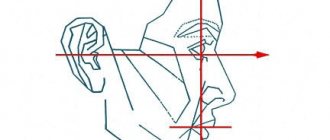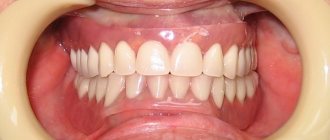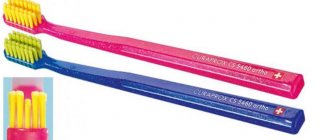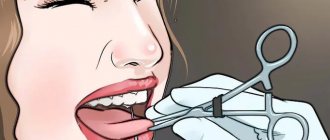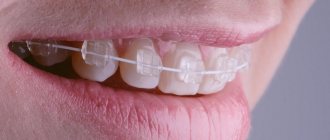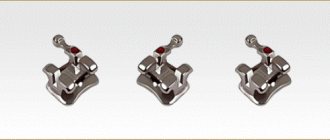Is it necessary to carry out hygienic cleaning before installing braces?
If there is evidence for this, then it is necessary, since braces must be installed on clean enamel. It is important that there is no accumulation of plaque underneath them, otherwise caries may develop under the braces. In addition, if there is a lot of plaque, it will be difficult to remove it with braces - it is better to do this before the system is fixed.
However, if you have recently had dental hygiene, it is better to postpone the procedure a little and go through it 2-3 months after installing the braces system - it will be much more effective.
What products are needed to care for teeth with braces?
Caring for teeth with braces
| Name | Description |
| Various toothbrushes | Braces are placed in stages: first on the upper jaw, after a few weeks or even months - on the lower jaw. Therefore, you can brush your teeth without braces as usual. But for those teeth that have braces attached, it is better to purchase a brush with a V-shaped groove specifically designed for braces. Additionally, thin mono-tuft brushes will be useful, which will allow you to reach narrow and hard-to-reach places and better clean the braces themselves. Try different options - this way you can choose the best and most convenient one for yourself, and your attending physician will evaluate how well you perform hygiene with the chosen products. |
| Toothpaste | After installing braces, teeth often break, the enamel becomes thinner, and the teeth react sharply to external influences. Therefore, a toothpaste for sensitive teeth must be in your arsenal. After the condition of the enamel is normalized, it can be changed to whitening or anti-plaque. Do not forget to change the paste every 3-4 months or even more often, selecting it in accordance with the problems that you have. |
| Interdental brushes and/or dental floss | Use after every meal, carefully cleaning the interdental spaces. Also use brushes under the arch and along the top of the plates - these are places where pieces of food often remain. Choose the product of the desired thickness - start with the thinnest ones and choose the option that is right for you, taking into account the size of the spaces between the teeth. It is better if the kit includes brushes of different sizes - for different intervals. |
| Irrigator | It is not only possible to use it, but also absolutely necessary to clean the interdental spaces. |
| Mouthwash | Choose any one that suits you - you can leave the one you used before installing braces. |
| Protective wax | Buy it on the first day, since braces (their protruding edges and arch) can rub the inside of the cheeks, especially in the first days. |
| Travel set | At first glance, this may seem like a waste of money, but this is a great option for those who travel often or lead an active lifestyle - throw this set in your purse and carry out hygiene after any snack. You can form it yourself by packing all the necessary products in a small cosmetic bag. |
Can I use an electric toothbrush?
Ultrasonic is not possible, conventional electric is possible. The first can lead to the plates coming off, the second should not have a moving head and strong vibration - this will not harm the braces, but it will be inconvenient for you to use such a brush, since the bristles will get stuck. You can use several toothbrushes at once - a regular one to clean the inner surface of the teeth, and an orthodontic one to clean the outer surface where the braces are located.
“The braces are fixed quite securely - you need to try hard to peel them off the surface of the teeth. Therefore, hygiene must be carried out without fear and in no case reducing its intensity, making allowances for braces. If the care is poor, after removing the system we will find caries and white spots on the enamel.”
Vagapov Zakir Irkinovich, dentist-orthodontist, work experience over 16 years make an appointment
Categorical prohibitions
When wearing braces, the following are strictly prohibited:
- Temperature changes. If you replace cold food with hot food or vice versa, the brace system may be damaged.
- Biting on hard vegetables and fruits. Such products should be cut into pieces.
- Using a regular toothbrush. The cleaning product must be marked as orthodontic.
- Use of needles and other sharp objects.
- Ignoring the breakdown. If the structure breaks down at the slightest level or one of its elements comes off, you should immediately consult a doctor.
What diet should you follow?
There are three main rules that must be followed after installing braces:
- avoidance of excessively hard and “sticky” foods – nuts, seeds, toffees, chewing gums,
- hard fruits and vegetables, meat must be cut into small pieces, chewing with side teeth,
- food and drinks should be warm, but not hot - this can lead to the records coming off.
Your diet should remain unchanged, with the exception of the three points listed. Do not overuse liquid and soft foods - your teeth must receive stress for normal functioning. You can minimize the consumption of viscous foods (chocolate, waffles, chips) - but not because they are prohibited, but because they accumulate on braces and under the archwire. They will simply be very difficult to remove.
Nutritional Features
Patients have to adhere to a certain diet. This does not mean that you will have to eat less or only low-calorie foods. Restrictions will apply to hard and viscous products and drinks that contain a lot of dyes.
You should also be careful with very hot or extremely cold foods. Do not drink ice cream with coffee - temperature changes will lead to loss of elasticity of the structure.
Try to make your diet balanced. This is a good prevention of bacterial infection in the oral cavity. In addition, eat foods rich in protein and microelements (especially calcium, fluoride) to preserve enamel - eggs, fish and seafood, dairy products, fruits and vegetables.
There are several recommendations regarding food intake:
- Use a knife. Any dish that allows this should be cut into pieces, only then placed in the mouth. Avoid chewing large pieces for a long time. Distribute the load evenly.
- Don't bite apples, cucumbers, or any other fruits or vegetables with your front teeth. When eating them, also use cutlery.
- Try to eat at home or in an environment where you can rinse your mouth and use dental floss. Do not neglect this rule after every meal.
Eliminate hard foods
This is meat, apples and other fruits, vegetables with strong skins, and nuts fried over a fire. Despite the fact that the design of braces is quite strong, excessively hard food can cause harm to it.
The most reliable systems, in terms of susceptibility to mechanical damage, are metal, classic ones. Plastic, ceramic or sapphire are considered more fragile. Therefore, you should handle them carefully.
Avoid sticky foods
You will need to remove from your diet not only hard foods, but also those that have a viscous consistency, for example, caramel, candies such as toffee. They get very stuck in the spaces between the teeth and arches and are then difficult to clean out.
Don't use dyes
The last restriction on the menu concerns products with bright coloring properties. They should be abandoned, especially if the patient wears a plastic structure. This includes tea and coffee, beets, various sodas, and red wine. We also include cigarettes in this category. While wearing braces, you should give up this bad habit.
How to eat immediately after getting braces
In the first 1-2 weeks after installing braces (as well as after their activation), especially with a significant defect and the choice of ligature structures (they put more pressure on the teeth than self-ligating ones), you will experience pain. The degree of intensity is completely different and depends on many factors, including your sensitivity. Therefore, if at first you find it painful and unpleasant to eat your usual food, change it to a more liquid one - give preference to soups, dairy products, yoghurts, or puree the main dishes. This will reduce the load on the teeth and reduce painful manifestations.
Rules for daily hygiene care
If you have braces, you should make it a rule to take care of your teeth every day - morning, evening and after every snack. This will help maintain healthy teeth and a snow-white shade of enamel after removing braces.
- Brush your teeth with a brush and toothpaste in the morning and evening. If you have a special brush, it is necessary to carry out horizontal movements along the arch of the braces (there is a recess inside the bristles for the arch). Use a regular brush without strong pressure, using both horizontal and vertical movements. Move the head actively, clean each record separately,
- After the main cleaning, use a single-tuft brush or brushes to clean every gap between the brackets/archwires, the surface of the teeth, as well as the plates themselves, top and bottom. Pay special attention to the brackets that are located on the farthest teeth - it is on them that the largest amount of plaque accumulates, since it is with these elements that we chew food,
- Rinse your mouth with water and mouthwash for 1-2 minutes.
Cleaning can also be supplemented with an irrigator (can also be directed at the plates - the pressure should be reduced only in the presence of ceramic and sapphire systems) and dental floss.
Types of designs
Braces can be classified according to different criteria.
Regarding location they are:
- vestibular, located on the front side of the dentition (allow you to achieve maximum results, but affect the aesthetics of the smile);
- lingual, fixed on the back of the dentition (they are completely invisible, but their treatment will take longer, and problems with diction may also arise).
Regarding the type of fastening, systems can be with direct and indirect fixation.
Regarding the type of connection of the bracket system arc with its plates, designs can be non-ligature (equipped with special clips that lock the arc) and ligature (ligatures are used to lock the arc).
The duration of wear is also the object of classification of braces. Systems can be:
- urgent (they are worn for no more than six months);
- average duration (six months to a year);
- long-acting (more than a year).
Depending on the material being manufactured, bracket systems are distinguished:
- metal (stainless steel or nickel-titanium alloy are used for their manufacture); composite (polyurethane is used as the manufactured material);
- ceramic (aluminum polycrystals are used); metal-plastic (metal frame covered with a layer of ceramics);
- plastic (transparent);
- sapphire (from artificial sapphires);
- from precious metals (gold, platinum).
Why do my teeth hurt after installing and activating braces?
In the first days after installation, and subsequently after activation of braces, aching sensations of varying degrees of intensity are possible - the stronger the defect, the greater the pain. When fixing ligature systems, the pressure is greater, so the teeth will hurt more. Soreness in general is a completely normal reaction, since braces from the first minutes after fixation already have an impact on the teeth and change their position.
If the pain is severe, then in the first days after installation or activation of the system, you can take painkillers. But no more than 2-3 days. If discomfort persists, contact your orthodontist for system correction.
Cleaning before braces: why is it needed?
Correction of the bite always begins with sanitation of the oral cavity. In addition to treating diseases of the teeth and gums, it includes mandatory professional cleaning before installing braces. The doctor will remove hard deposits with ultrasound, and soft deposits with a thin and powerful jet of cleaning powder solution (AirFlow technology). After this, the teeth will need to be polished with a special paste and coated with a fluoride-containing preparation to strengthen the enamel. Such a hygienic procedure should be carried out 3 - 5 days before installation, but no later than 24 hours.
What happens if you don’t brush your teeth before braces? Bacterial plaque will get under the elements of the system, in particular under the clasps that are glued to the enamel. Considering that orthodontic appliances are worn for a year at best, and two years on average, microorganisms will have enough time to multiply and lead to the formation of caries. It is impossible to properly cure it with braces on the teeth. There is a risk of early removal of the device, and this will spoil the final result, and the patient will waste money, time and moral strength. This is why brushing your teeth before getting braces is mandatory.
What to do if your braces chafe?
For inflammation of the mucous membranes, you can use special gels and ointments that have an antiseptic and soothing effect - for example, Metrogyl Denta, Vinilin.
To prevent inflammation, it is also recommended to use orthodontic wax. The purpose of its use is to isolate and protect soft mucous membranes from solid elements of the system. Apply to sharp protruding parts and replace as they fall off. It is recommended to remove the wax while eating.
Silicone strips for braces, like wax, are used to protect soft mucous membranes. Silicone is presented in the form of strips that can be used to cover one bracket or the entire row. Unlike wax, it does not crumble and is used repeatedly.
Adaptation to braces
The corrective design can be compared to a pair of shoes. No matter how comfortable they are, they need to be broken in. Accustomation lasts up to a week, however, some lingual varieties require a whole month. The patient will not feel significant pain. In the first few days you may feel:
- Pressure on the soft tissues of the oral cavity.
- Feeling of chafing on cheeks.
- Difficulty with articulation.
- Inconvenience when chewing food.
But such manifestations should not scare you, they are temporary and go away on their own. When wearing it, you should not change your habits and daily routine in any way; you need to live a normal life, communicate with loved ones and friends. Moreover, this is inevitable - until the straightening process occurs, it will not be possible to remove the staples. And the only thing patients can do is endure a little inconvenience.
If you feel that the mucous membranes of the oral cavity are severely damaged by friction, or your speech has been significantly affected, you can use a special protective wax. It is sold in pharmacy chains.
The aching nature of the pain intensifies when chewing food. If the patient has a low pain threshold and high sensitivity, mild analgesics may be needed. In case of severe irritation or inflammation of the mucous membranes, you can rinse your mouth with a solution of chamomile or calendula. After a week of getting used to it, you will not have any unpleasant sensations, but only a nice metallic “decoration” of your smile.
Unlike vestibular braces, the installation of lingual braces will require a longer adaptation period. You may need to endure the inconvenience for up to one month. They will mainly concentrate in the area of articulation. Oral speech will be slightly complicated and modified. But patience pays off in that such structures are practically invisible from the outside. And if you order them to be made according to individual measurements, then the discomfort in the first weeks is virtually completely absent.
If the patient has severe pain, stomatitis, wounds in the mouth, or a filling has fallen out, then you should definitely consult a doctor and not self-medicate.
What to do if the bracket comes off?
This happens quite rarely. And, as a rule, with budget models that are initially poorly fixed, or after some time after using the system. In such a situation, you need to make an appointment with the orthodontist as quickly as possible, or even come without an appointment during his working hours: gluing the plate will only take a few minutes. Metal braces can be re-glued at least 2-3 times. Ceramic or sapphire - also 1-2 times, but you need to look at their general condition.
It is unlikely that the bracket will be swallowed, since even if it comes off the surface, it will still be fixed to the arch with the help of ligatures or locking fastenings. If the plate does fall off, do not throw it away, but be sure to take it with you to your doctor’s appointment.
Terms of wearing
With the help of modern braces, you can correct various bite problems and get a beautiful smile. However, such a result can only be achieved with constant long-term wearing of braces.
On average, braces are worn for one and a half to two years. It depends on the age of the “bracket bearer” and the complexity of the situation.
Note: At the first consultation, the doctor can only announce the approximate duration of the upcoming treatment. Further, it may change depending on the characteristics of the patient’s body and the speed of movement of the dental organs.
It is impossible to artificially shorten the wearing period. But it is just possible to lengthen it. And this directly depends on the gaps in caring for braces and teeth.
When a bracket comes off, it needs to be glued back as soon as possible. If it also gets lost, you can waste time waiting for a new one to be made. Then the duration of treatment is likely to lengthen. Therefore, it is better to prevent breakage or peeling by carefully inspecting the structure every day.
Scheduled visits to the orthodontist should be timely. It is necessary to replace ligatures and arches, as well as clean the structure on time.
How often should I visit a doctor after getting braces?
If you have ligature systems, you need to visit your doctor monthly. Self-ligating ones also require regular correction, but the frequency is slightly less - every 1.5-2 months. In addition, every 2-3 months you will need professional oral hygiene. And it is better to have it done in the same clinic where you got your braces - your attending physician will carefully remove the arch, you will undergo the procedure, after which he will return the arch to its place. This way the system will not be damaged, and you will get teeth that will be thoroughly cleaned of plaque.
